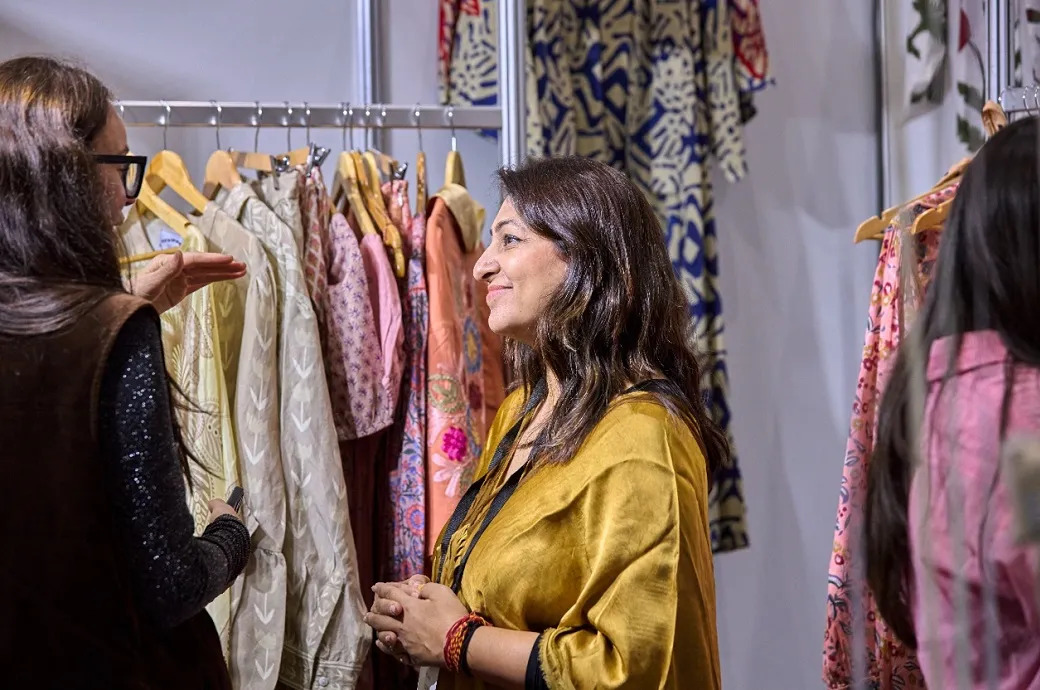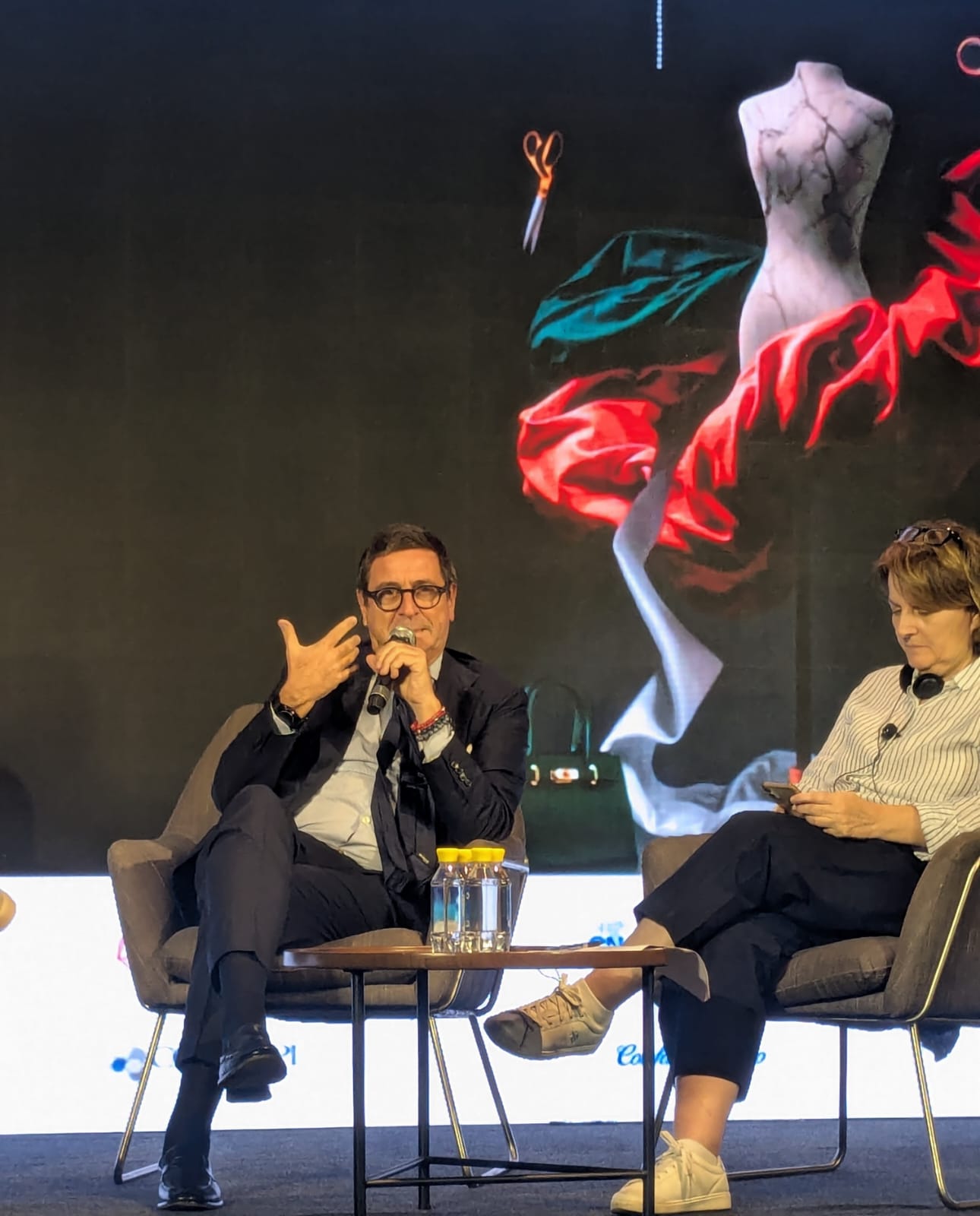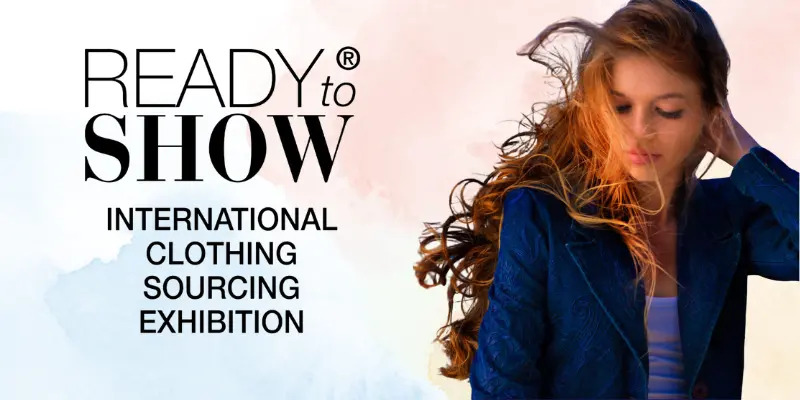FW
The recent Cinte Techtextil China fair concluded with a buzz, leaving industry professionals reflecting on the future of textiles and groundbreaking advancements. Sabine Scharrer, Director of Brand Management for Technical Textiles & Textile Processing at Messe Frankfurt, offered attendees a forward-looking presentation, spotlighting the upcoming Techtextil and Texprocess fairs in Frankfurt, Germany, which serve as the "mother show" for the global textile industry.

Scharrer emphasized the strength of the Texpertise network, a vast connector linking over 150,000 industry players across more than 60 trade shows in 13 countries. She highlighted the Frankfurt shows—Techtextil and Texprocess—as the global flagship events, underscoring the invaluable role of "unplanned encounters" in fostering innovation and progress within the industry.
The presentation delved into the diverse applications of technical textiles, spanning critical sectors like automotive, medicine, fashion, and construction. Texprocess, the companion fair, was introduced as the hub for machinery that transforms "textile dreams into hard-working realities" through digitalization, AI, and cutting-edge efficiency tools.
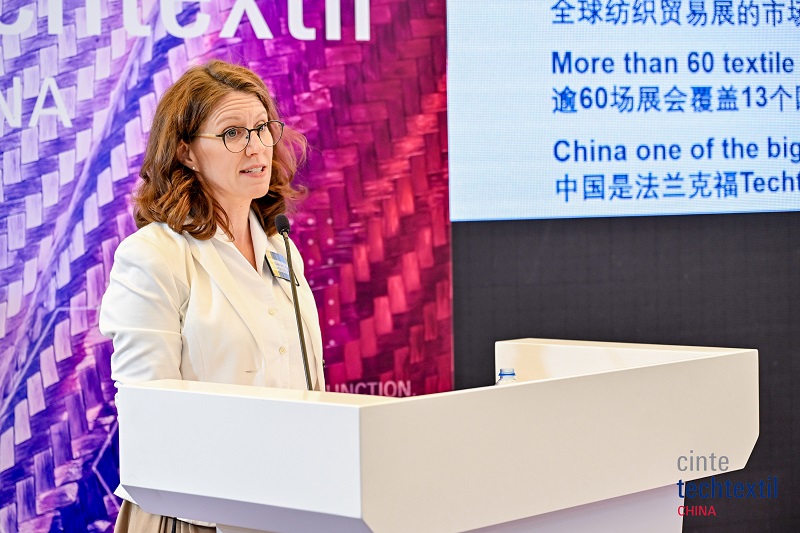
Impressive figures from the 2024 Techtextil edition were shared, reporting 1,469 exhibitors and approximately 35,000 visitors from over 100 countries, marking it as the largest and most international show to date. Scharrer noted the powerful synergy between the two fairs, with a significant overlap in visitors: 72% of Techtextil attendees also visit Texprocess, and a remarkable 90% of Texprocess attendees visit Techtextil. This interconnectedness ensures a holistic view of innovations, from material to finished product.
Looking ahead to the next Frankfurt shows, exciting additions were announced. A new, dedicated product group for Textile Chemicals and Dyes will be introduced, already attracting around 30 exhibitors. This segment will be strategically placed next to the performance apparel area, strengthening ties with a growing customer base. The Performance Apparel Textiles area itself will also move closer to Texprocess to enhance its connection with the garment industry, responding to the rapidly increasing demand for performance textiles, particularly in outdoor and personal protection.
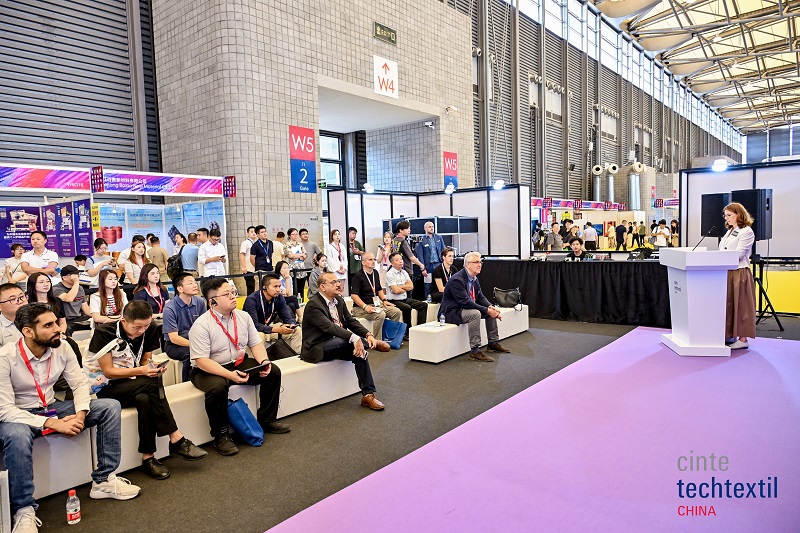
Sustainability was a central theme, woven throughout the presentation as a critical focus across all Messe Frankfurt fairs. Scharrer cited initiatives like the Econogy Tour and the Sustainability Forum as key examples of this commitment. She acknowledged the rising demand for sustainable alternatives and the growing impact of regulations, such as new textile strategies. Innovations like natural dyes, biodegradable polyester, and organic fibers were showcased, alongside discussions on challenges, including the use of "forever chemicals" (PFAS). To guide attendees, the Econogy Shift Finder was introduced—a verified directory of exhibitors offering certified sustainable products.
The next Frankfurt show in 2026 is anticipated to be a truly international gathering, with 1,500 international participants expected. The return of renowned names such as Akuma and Guttner, along with over 120 new and exciting exhibitors like Luma and Carrington, promises a dynamic event. Scharrer concluded by expressing eagerness to witness the fresh ideas and innovations these participants will bring, affirming Messe Frankfurt's role in driving the future of the textile industry.
The air in the Shanghai New International Expo Centre on September 4, 2025, hummed with a specific kind of industrial anxiety. It wasn't the noise of competition; it was the silent pressure of global compliance.
Lina Chen, founder of Lotus Technical Fabrics, felt that pressure acutely. On her tablet was an open email chain detailing the demands of a massive European public tender—a railway commission needing sustainable, high-durability seating fabric. The tender documents alone stretched to nearly forty pages. Lina’s cutting-edge bamboo composite fabric was technically superior, but the mountain of bureaucratic proof required was suffocating her small team.

She found a seat in the crowded seminar hall just as Karl Borgschulze, MD of Consulting Service Intl Ltd, took the stage to lead the Eonology Tour session.
“This is a really important part of the business here today,” Karl began, his voice calm yet firm. “Legislation around the globe is becoming more and more important.”
Lina didn’t need convincing. Her desk back in Suzhou was buried under sustainability certificates. She watched as Karl introduced the unified platform: the Texpertise Economy Network, now rebranded under the single concept of Eonology—a direct portmanteau of ‘ecology’ and ‘economy.’
Karl pivoted to history, offering a crucial perspective that resonated deeply with Lina’s entrepreneurial spirit. “Messe Frankfurt very early already recognized that sustainability is and will be a more and more important part of the global textile business,” he explained. He noted that the initiative began almost fifteen years ago, long before it became a mandate. He then delivered his central argument, a quote Lina typed onto her notes, “Textile is always ahead of other industries, let’s not forget that. We were the first ones for industrialization, we were the first ones for globalization, and we are the first ones who put the full pressure on environmental and social requirements, which is a big advantage that we are ahead of many other industries.” Lina realized the pressure wasn't a punishment; it was the cost of being a pioneer.
Karl continued, tackling the challenge of complexity head-on. He cited the bureaucratic burden currently paralyzing innovators like her. “If you go for public tenders in Europe,” he said, “sustainability requirements are a fundamental part of the tender, and you have to fill out papers, 30 pages, 40 pages.” He paused for emphasis. “If you ever have applied for something, for example for Deutsche Bahn in Germany, then you know what it means to deal with German bureaucracy.”
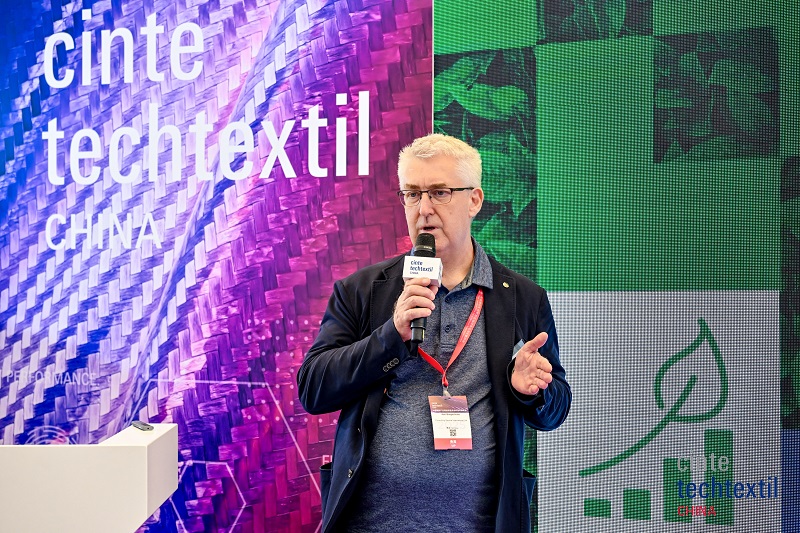
His words perfectly articulated Lina’s pain, but the key to Eonology, Karl stressed, was not avoiding the rules, but providing a framework rooted in the United Nations Sustainable Development Goals (SDGs), aligning global standards with OECD and ILO guidelines.
Then came the critical case study. Karl discussed the delicate balancing act at the heart of the Eonology principle, stating, “It’s keeping in balance ecology, social aspects, and economy.”
He elaborated on how performance sometimes necessitates trade-offs: "For example, on textile, very often performance is the most important thing, so certain other environmental aspects might be minor, because it’s more important to protect the life of a fireman or firefighter, and therefore we might have to use certain substances we wouldn’t not use in apparel for a private person.”
The firefighter analogy was a thunderbolt for Lina. Her bamboo composite met 95% of the sustainability demands, but the necessary fire-retardant finish pushed her score slightly lower on certain chemical metrics. She had been apologizing for this small deficit. Now, she realized she had to reframe it. Her fabric was for public transport—a safety application, protecting thousands of passengers daily. Performance was the most important social factor.
Lina immediately scanned the QR code for the Texpertise Network displayed on the screen. The Eonology system wasn't just a label; it was a guidance system designed to align her product's performance priority with globally recognized frameworks.
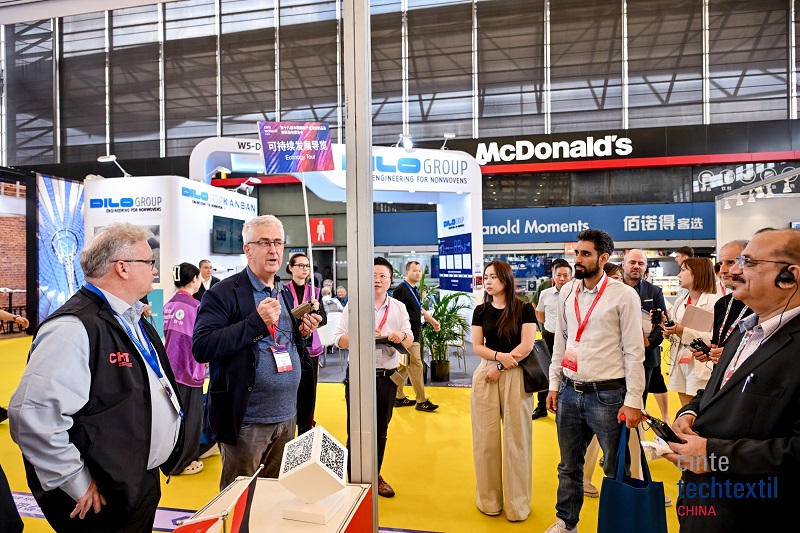
Karl Borgschulze concluded with an encouraging note: “The great thing is, if you have a problem, come here, and I'm pretty sure you will find an idea and someone who is able to support you in exactly what you are looking for. Because the industry is really innovative.”
Lina left the hall, the oppressive weight of the 40-page tender replaced by clear purpose. She wasn't just selling sustainable fabric; she was selling compliance, guided by the Eonology framework. She knew exactly which two Eonology-certified chemical suppliers to visit next, not to find greener alternatives, but to find partners who could document the necessity of her chosen, life-protecting treatment within the accepted, performance-driven Ecology-Social-Economy balance. The battle against bureaucracy wasn't won with just a better product, but with a better system.
Moscow Fashion Week, held from August 28 to September 2, 2025, served as a powerful showcase for designers who masterfully explored the art of contradiction. The event, held in conjunction with the BRICS+ Fashion Summit, highlighted how designers from Russia and beyond are using opposing forces—fragility and strength, tradition and modernity, softness and structure—to create dynamic and compelling fashion.
From Rococo to grunge

Designers found a compelling narrative in the juxtaposition of different eras and aesthetics. Alina Vladi Brand Wear from Kazan opened its show with a dreamy Rococo theme, featuring airy silhouettes, pearl beads, and soft tones. But the collection quickly took a rebellious turn, shifting to heavy fabrics, frayed edges, and chains that channeled the spirit of grunge. This dramatic contrast reflected the duality of the modern woman, capable of embodying both elegance and a fierce, unapologetic strength.
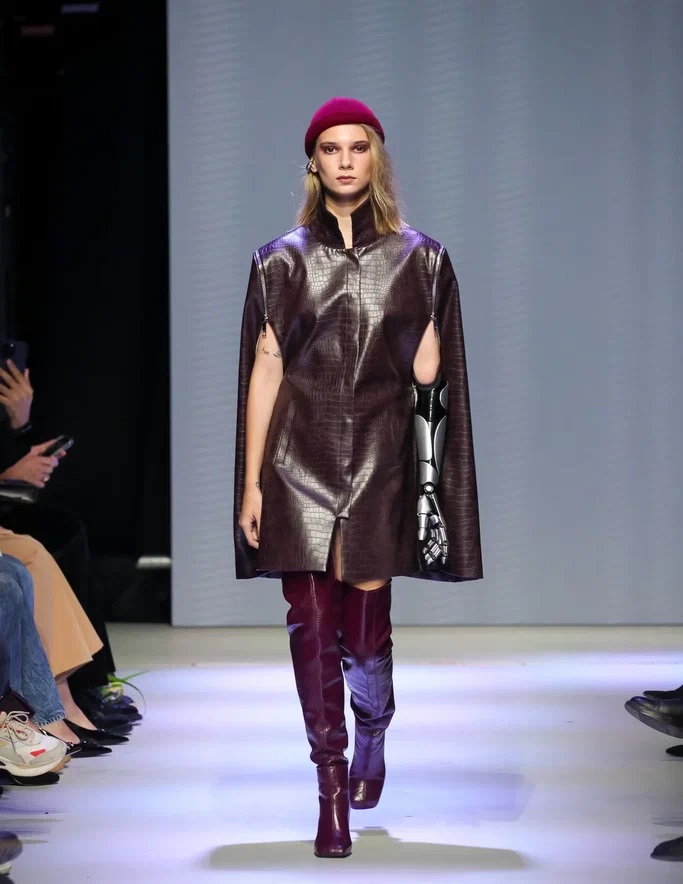
Similarly, the Addicted to... brand combined glamorous, sensational trends with a casual, everyday style, pairing luxurious fur coats with rebellious snake-print dresses and sequined suits with casual beanies.
Balancing softness and structure

Many collections explored the tension between delicate and rigid materials to create a sense of harmony. SaiJamin, a brand rooted in Circassian heritage, used its "Threads" collection to balance bohemian softness with sharp, architectural lines. Flowing dresses were paired with structured bustiers and statement belts, creating an elegant dialogue between vulnerability and power.
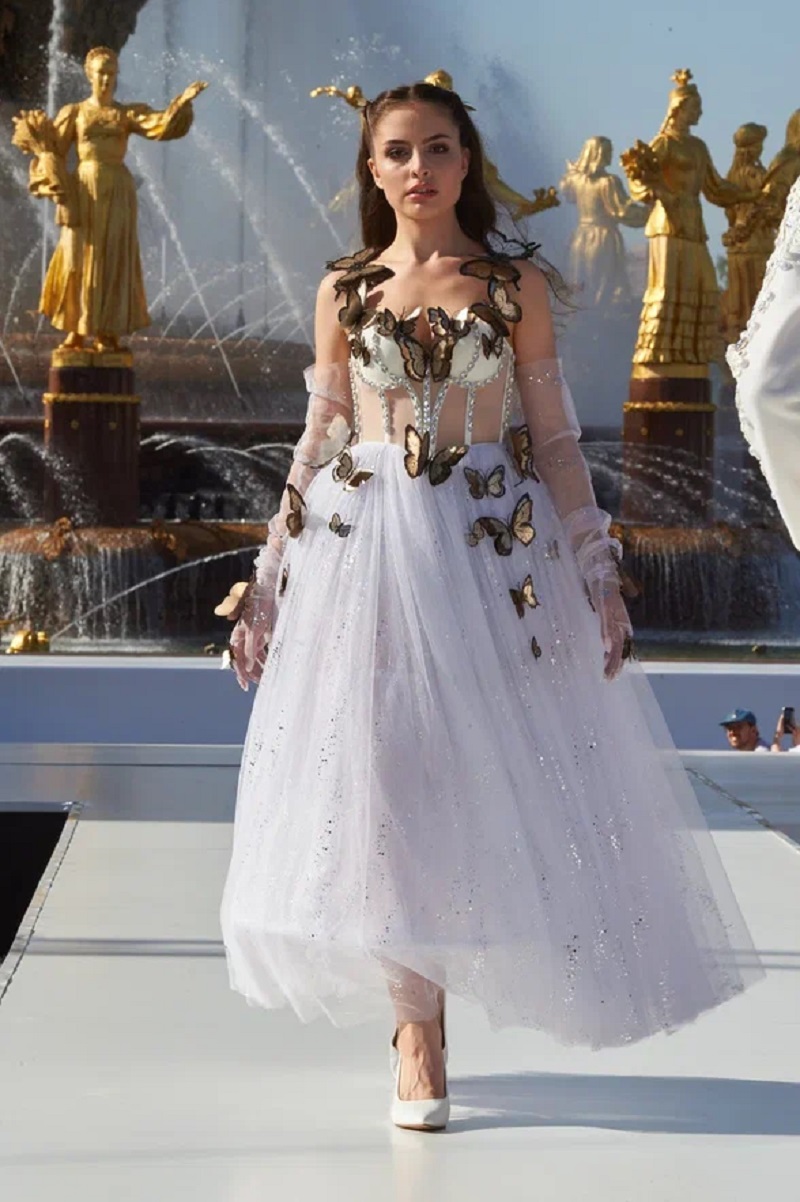
In a similar vein, Akkulova Albina wove together Slavic refinement and Caucasian elegance, using asymmetrical cuts and layered silhouettes to build architectural structure into her pieces.
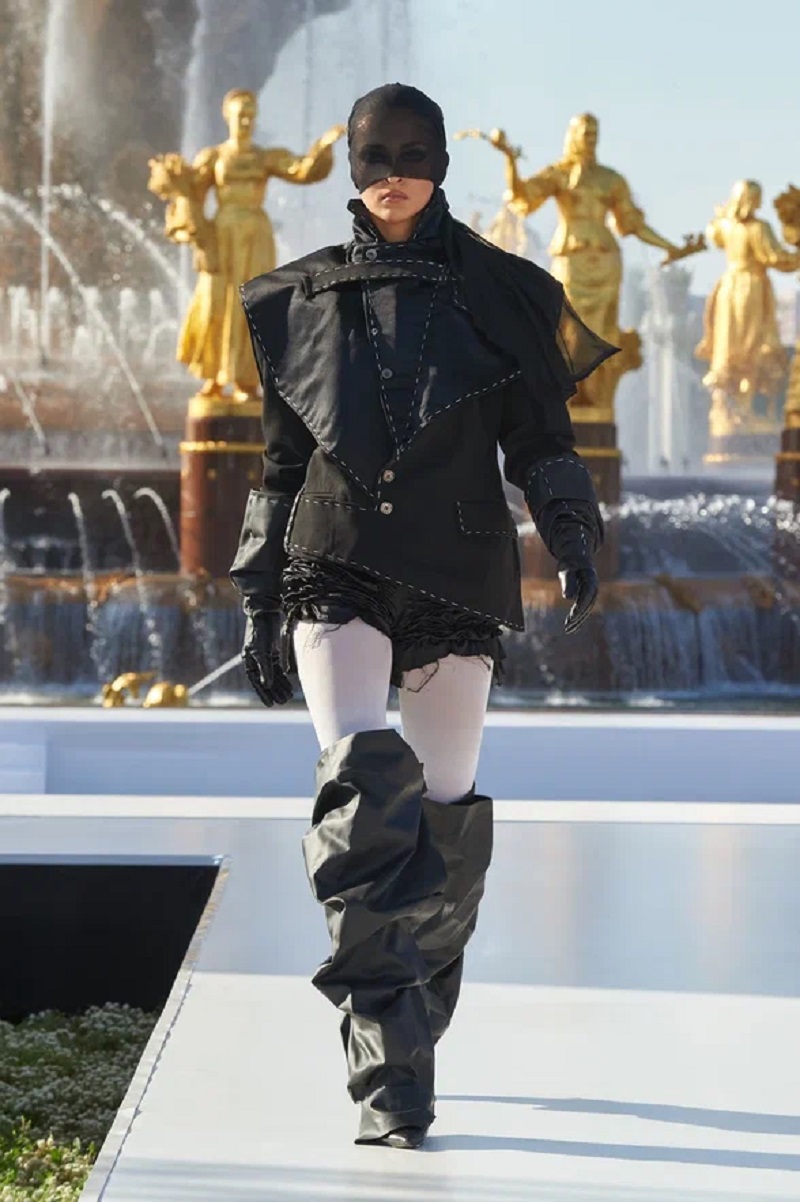
The Academy of Branding and Design METRICS focused on the interplay between contrasting textures, pairing lightweight chiffons with denser materials to create a sophisticated balance. And Alena Nega's "Bliss" collection used a similar approach, combining semi-transparent fabrics with substantial suiting materials to craft an enigmatic and compelling aesthetic. The RUBAN brand took this concept to a new level, using layers of weightless organza and chiffon to create a three-dimensional effect that was both airy and sculptural.
Timelessness Through Contrast
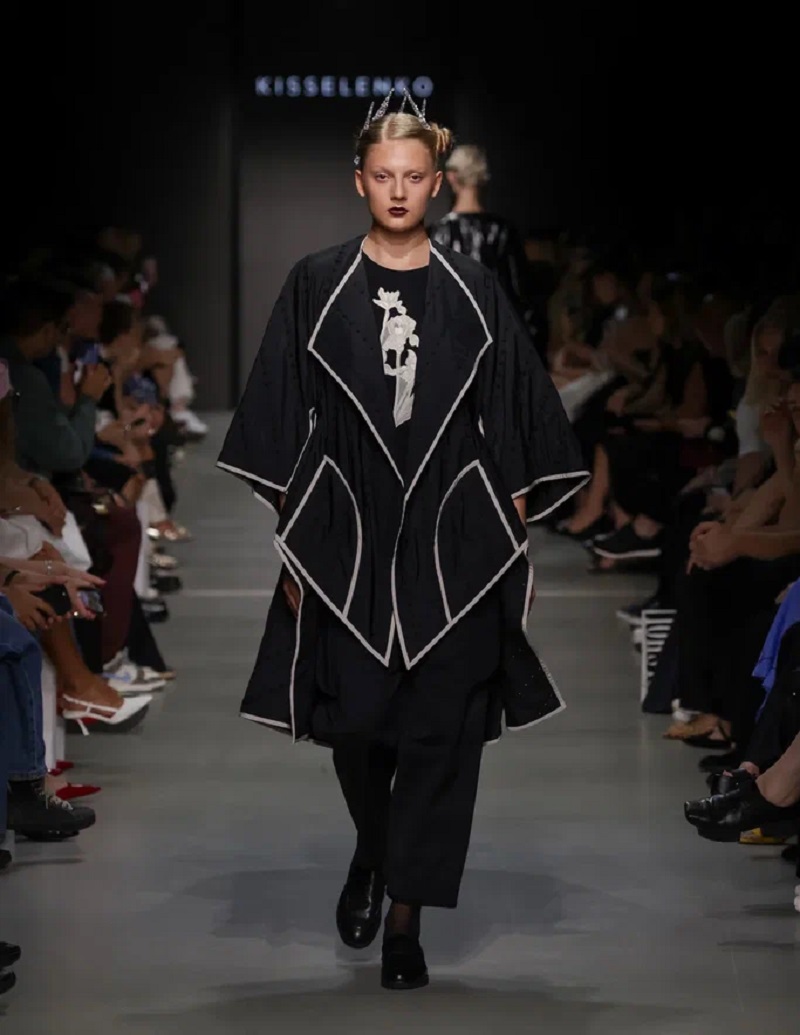
Other designers explored the tension between past and present to create collections that felt timeless. The St. Petersburg brand Kisselenko used a minimalist approach and Oriental touch, blending strict geometry with asymmetrical tailoring to create pieces that could be layered and combined in countless ways. This fusion of tradition and modernity allowed for versatile, long-lasting fashion.

Finally, Surovaya's collection celebrated "timeless classics" rather than fleeting trends. By using a monochromatic palette and elegant, clean silhouettes, the designer proved that a focus on impeccable tailoring and quality can create a powerful statement without relying on passing fads.
Moscow Fashion Week, held from August 28 to September 2, 2025, served as a powerful showcase for designers who masterfully explored the art of contradiction. The event, held in conjunction with the BRICS+ Fashion Summit, highlighted how designers from Russia and beyond are using opposing forces—fragility and strength, tradition and modernity, softness and structure—to create dynamic and compelling fashion.
From Rococo to grunge

Designers found a compelling narrative in the juxtaposition of different eras and aesthetics. Alina Vladi Brand Wear from Kazan opened its show with a dreamy Rococo theme, featuring airy silhouettes, pearl beads, and soft tones. But the collection quickly took a rebellious turn, shifting to heavy fabrics, frayed edges, and chains that channeled the spirit of grunge. This dramatic contrast reflected the duality of the modern woman, capable of embodying both elegance and a fierce, unapologetic strength.

Similarly, the Addicted to... brand combined glamorous, sensational trends with a casual, everyday style, pairing luxurious fur coats with rebellious snake-print dresses and sequined suits with casual beanies.
Balancing softness and structure

Many collections explored the tension between delicate and rigid materials to create a sense of harmony. SaiJamin, a brand rooted in Circassian heritage, used its "Threads" collection to balance bohemian softness with sharp, architectural lines. Flowing dresses were paired with structured bustiers and statement belts, creating an elegant dialogue between vulnerability and power.

In a similar vein, Akkulova Albina wove together Slavic refinement and Caucasian elegance, using asymmetrical cuts and layered silhouettes to build architectural structure into her pieces.

The Academy of Branding and Design METRICS focused on the interplay between contrasting textures, pairing lightweight chiffons with denser materials to create a sophisticated balance. And Alena Nega's "Bliss" collection used a similar approach, combining semi-transparent fabrics with substantial suiting materials to craft an enigmatic and compelling aesthetic. The RUBAN brand took this concept to a new level, using layers of weightless organza and chiffon to create a three-dimensional effect that was both airy and sculptural.
Timelessness Through Contrast

Other designers explored the tension between past and present to create collections that felt timeless. The St. Petersburg brand Kisselenko used a minimalist approach and Oriental touch, blending strict geometry with asymmetrical tailoring to create pieces that could be layered and combined in countless ways. This fusion of tradition and modernity allowed for versatile, long-lasting fashion.

Finally, Surovaya's collection celebrated "timeless classics" rather than fleeting trends. By using a monochromatic palette and elegant, clean silhouettes, the designer proved that a focus on impeccable tailoring and quality can create a powerful statement without relying on passing fads.
Moscow Fashion Week, from August 28 to September 2, 2025, wasn't just a global hub for designers; it was a celebration of the city itself. Designers used the canvas of the runway to tell stories inspired by urban life, from the architecture of Moscow to the landscapes of other Russian cities. This creative dialogue between place and fashion showcased the distinct character of each location.
The spirit of Moscow
Moscow's own designers were deeply inspired by their home city. Brands like FLASHIN and The Vow presented collections that captured the capital's energy,

with The Vow's line in particular drawing on the elegant history of 19th-century Moscow. Other designers found inspiration in more abstract concepts of the city.
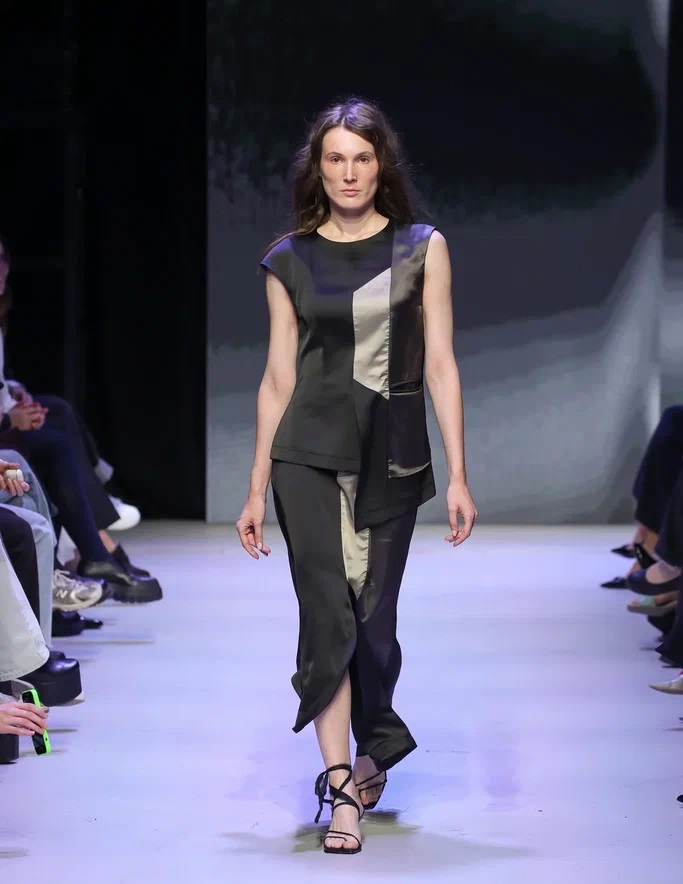
Persve explored the architectural deconstruction of Frank Gehry, translating complex structures into daring, asymmetrical ready-to-wear. Mexa Ekaterina reimagined fur for a "Big City" context, creating practical and stylish pieces for urban life. Even more personally, Sasha Barbakov's "Gardens Bloom in the Soul" was a tribute to his grandmother's garden, a quiet, nostalgic corner of Moscow brought to life through fabric prints.
Saint Petersburg's architectural elegance

The cultural capital of Russia, St. Petersburg, also had a strong presence. Ianis Chamalidy presented a collection with "architectural tailoring," using deep, subtle tones and structured silhouettes that echoed the city's grand facades. This was a direct conversation with the urban landscape, as was the work of 139Dec, which explored the crossroads of avant-garde fashion and architecture.
Kisselenko's minimalist designs with an Oriental touch reflected the city's refined, artistic spirit,

while Stas Lopatkin's chinoiserie-inspired collection offered a more ornate and theatrical vision of the city's rich history.
From the steppes to the sea
Pic-5
Designers from other Russian cities brought their regional identities to the national stage. Alina Vladi Brand Wear from Kazan played with dramatic contrasts, much like the city itself, which blends Tatar and Russian cultures.

Tatiana Kotova from Chelyabinsk was inspired by a "Night Garden," and Anna Kropotova from Rostov-on-Don created sculptural silhouettes inspired by the icy formations of Siberia's Lake Baikal. Meanwhile, Les Noms from Krasnodar dedicated their collection "My Land" to the native Kuban region, telling a story of a place shaped by the intersection of many cultures.
This season, Moscow Fashion Week transcended the traditional runway, proving that a city's identity can be a powerful source of creative inspiration. Designers didn't just showcase clothes; they wove narratives of urban energy, historical elegance, and regional identity into every stitch. The event became a vibrant dialogue between fashion and place, celebrating the diverse cultural and architectural landscape of Russia and beyond.
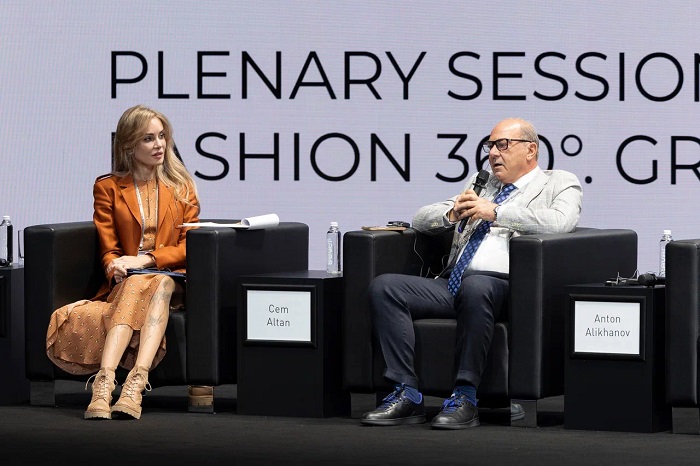
For decades, the global fashion industry has revolved around the orbits of Paris, Milan, New York, and London. But a new constellation is rising in the East, and its gravitational pull is undeniable. This shift was the central theme of the recent BRICS+ Fashion Summit in Moscow, a gathering that, in its third year, is challenging the established norms of the apparel world.
In an exclusive interview with FashionatingWorld, Cem Altan, President of the International Apparel Federation (IAF), described his attendance as a personal mission to foster connectivity—and reflected on how geopolitical shifts are unintentionally fueling the rise of a ‘non-Western’ fashion powerhouse.
Altan as a "Peace Ambassador"
While the IAF's official engagement with Russian partners is temporarily on hold due to sanctions, Altan’s personal participation as a "peace ambassador" underscores his belief that fashion can build bridges where politics erect barriers. He sees fashion as a "global attraction" and a powerful force that can bring "people together, countries together," transcending conflicts that restrict official collaboration. For him, the summit is the perfect stage for this philosophy—a place where business and cultural exchange thrive, even in a politically charged environment.
The Power of Population: A market too big to ignore
The economic and demographic reality of the BRICS+ bloc makes it impossible to overlook. With its recent expansion to 11 member countries—including Iran, Saudi Arabia, the UAE, Egypt, and Ethiopia—the group now represents roughly 42–43% of the world’s population.
"You cannot really close your eyes to this community," Altan stated emphatically. He views BRICS+ not just as a cluster of nations but as a collective power with immense potential for collaboration. With over 60 countries participating in the summit, the platform, he explained, enables "joint economical projects, cultural projects" that allow members to "help each other to grow together." This shared growth, he argues, is shaping a new and influential pole in the global fashion economy.
From Neglect to the Catwalk: A platform for new voices
One of the summit’s most compelling features, according to Altan, is its role in democratizing fashion. He expressed particular pride in the presence of designers and professionals from Africa, a community he says has been "neglected for many, many years." BRICS+ is offering them overdue visibility to showcase the "richness" of their culture and products, and to "add to the global community."
This focus on emerging and overlooked regions is central to the summit’s philosophy—an intentional effort to expand fashion’s horizons beyond traditional centers and create a more inclusive and representative dialogue.
The Traveling Summit: Building a global network
Looking ahead, Altan envisions the BRICS+ Fashion Summit evolving into a traveling event. He suggested it should rotate among BRICS nations—whether India, China, or African members—so that "local people" can directly "benefit out of it."
Such a dynamic approach would deepen cultural and economic exchanges, enabling nations to share resources, strengths, and values. For Altan, it represents a peaceful movement toward building a new kind of global network, where collaboration and respect bind the industry together.
Nurturing the next generation
While acknowledging these are "start-up deals" that take time to mature, Altan sees the summit as a vital stepping stone. It offers young designers and new entrants the chance to learn, listen, and gain experience from international experts. He called the Russian government’s support "very clever," recognizing its importance in cultivating the next generation of creative and business leaders.
A new world order in fashion and apparel
The rise of the BRICS+ bloc in fashion is not just about market size; it is about cultural exchange and the democratization of an industry historically dominated by a few. As the global economy continues to rebalance, Altan’s perspective suggests the future of fashion will be more diverse, collaborative, and far less reliant on the West.
The BRICS+ Fashion Summit, he concluded, is not just a fashion show—it is a testament to the new centers of gravity reshaping the global apparel industry.
A B2B startup, Recove has successfully closed an Rs 5.3 crore pre-seed funding round to modernize and digitize plastics recycling supply chain.
Led by Momentum Capital, the fund round was attended by several prominent industry veterans and angel investors. Some of these participants included Ganesh Natarajan. Former CEO, Aptech & Zensar; Ashish Goel, Co-founder, Urban Ladder; Chaitanya Kejriwal, and Shruti Deorah.
Recove plans to use this new capital for three main purposes including expanding its tech-enabled B2B marketplace nationwide across India, setting up in-house pre-processing hubs and growing its network of recycling partners.
Founded in 2024 by Viral Chhajer, Nirja Bhatt, and Sharan Subaiah, Recove operates a technology-enabled marketplace that efficiently connects suppliers of plastic waste with recycling companies.
The company’s model integrates digital procurement with physical pre-processing infrastructure. This combination is designed to streamline the supply chain, ensuring that recyclers receive dependable, quality-assured raw materials while maximizing returns for waste generators.
Global leader in developing fiber and technology solutions for the apparel and personal care industries, The Lycra Company announced two strategic leadership moves to accelerate innovation and growth.
The Lycra Company has promoted Robert Johnston as its new Chief Operating Officer. A 35-year veteran of The Lycra Company and its predecessor organizations, Johnston will expand his leadership to include product development, in addition to his current oversight of global manufacturing operations and IT. In his new role, Johnston will manage R&D talent, lab resources, and pilot production to drive innovation across the product portfolio, supporting strategic growth priorities identified by Kelliher’s team.
Doug Kelliher has been appointed Executive Vice President- Product. He will lead the product management team in developing and executing strategy across fibers, fabrics, and garments. His team works to deliver differentiated solutions that add value and meet the needs of today’s consumer. With more than 30 years of product leadership experience at Timberland, Velcro Companies, Polartec and Milliken & Company, Kelliher brings deep expertise to his role.
The Lycra Company innovates and produces fiber and technology solutions for the apparel and personal care industries and owns leading consumer brands.. The company focuses on adding value to its customers’ products by developing unique innovations designed to meet the consumer’s need for comfort and lasting performance.
Reiterating that the sale of imported used clothing, or ‘thrifting,’ is strictly prohibited by law, the Indonesian Government is strongly urging the public to stop purchasing such products. The crackdown comes as thrifting remains rampant, driven by strong consumer demand across various digital platforms and marketplaces.
Reni Yanita, Director General, Small, Medium, and Miscellaneous Industries at the Ministry of Industry, states, they still exist because there is demand. That's why we continue to urge the public not to buy thrifted goods."
The surge in illegal imports is severely impacting domestic businesses. Data from Statistics Indonesia shows, imports of finished textiles, used clothing, and rags reached $78.19 million between January and July 2025, marking a 17.33 per cent Y-o-Y. The main sources for these goods include China, Vietnam, Bangladesh, Taiwan, and Singapore.
Highlighting the competitive disadvantage faced by local producers, garment entrepreneur Ellianah Setiady explains, the disruption from illegal importers, especially from China, is enormous. Production costs are high due to the regional minimum wage and taxes, while imported goods are much cheaper.
Setiady notes, illegal goods are increasingly being sold on digital platforms, including through live marketplace sales and personal shopping services from abroad. These practices clearly violate regulations and pose a significant risk to the domestic industry, she emphasizes. She urged the government to protect local businesses by re-establishing a task force dedicated to monitoring illegal imports.
On September 1, 2025, amidst the imperial grandeur and contemporary dynamism of Moscow, Indian couturiers Shantnu & Nikhil Mehra unveiled their first-ever women's couture collection, 'Armouré,' at Moscow Fashion Week. For a brand synonymous with redefining menswear for over two decades, this international debut was more than a runway show—it was a bold statement of evolution, cultural diplomacy, and the paradoxical nature of the modern woman.

The setting couldn’t have been more fitting. Moscow, a city where ancient domes meet neon lights, perfectly mirrored the collection's core tension: a fusion of strength and sensuality, romance and resistance. The show was part of a larger global fashion dialogue, as Moscow Fashion Week ran in tandem with the BRICS+ Fashion Summit, a gathering of fashion leaders and innovators from over 65 countries. This provided a powerful platform for Shantnu & Nikhil to position Indian couture not as a niche craft, but as a central, influential voice in the global conversation. As the designers shared, “Moscow represents a cultural crossroad, steeped in imperial legacy yet brimming with contemporary appetite for couture.”
'Armouré': A symphony of paradox
Inspired by the unapologetic glamour and daring spirit of 1930s icons, the 'Armouré' collection is a masterclass in duality. It celebrates a woman who is both intimate and armored, soft yet unyielding. The silhouettes beautifully showcased this contradiction: sharp, sculptural corsets were paired with whisper-thin, fluid drapery, while structured shoulders met cascading crystal embroideries.

The collection’s palette deepened the narrative, moving from dominion reds and midnight blacks to liquid silvers and opulent pearls. Metallic brocades shimmered like armor, and hand-applied embellishments served as both adornment and protection. Each detail, from a pearl-studded shoulder to a sequin-clad power-bodice dress, was symbolic—a reflection of the strength and allure inherent in the modern siren.
For the designers, this collection was about more than just aesthetics. As they explained, “Armouré was imagined around the paradox of the modern woman: sensual yet armoured, intimate yet resistant.
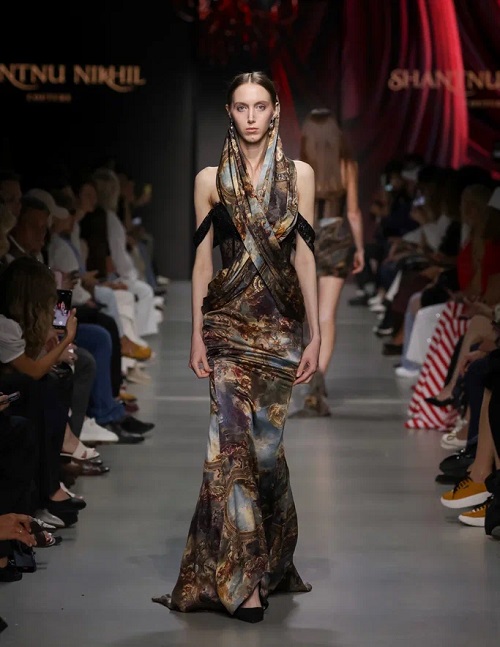
Every detail is symbolic—pearls represent intimacy, crystals embody allure, metallics signify strength, and embroideries carry the legacy of craft.” By weaving traditional Indian techniques into a global, avant-garde language, they proved that craft could be both celebrated and reimagined.
The significance of Moscow
This debut was a strategic move, positioning Shantnu & Nikhil at a pivotal cultural crossroad. As the designers noted, Moscow’s blend of imperial legacy and contemporary appetite for couture made it the ideal canvas.
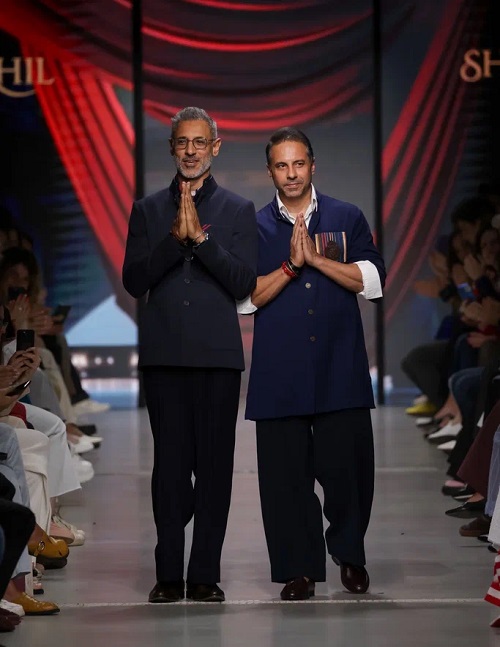
The Fashion Design Council of India (FDCI) played a crucial role in shaping this cultural bridge, championing Indian fashion on a global stage. As the designers themselves stated, “The Fashion Design Council of India (FDCI) has played a pivotal role in shaping this cultural bridge between India and Russia, the presence of Indian fashion and craftsmanship to a global audience.” Russian Federation Ambassador Denis Alipov affirmed the significance of this collaboration, highlighting how fashion can act as a form of cultural diplomacy—fostering dialogue and celebrating national identity.
The visionaries behind the brand
Brothers Shantnu and Nikhil Mehra founded their label in 2000, quickly earning a reputation for disrupting traditional Indian ceremonial wear. While many designers focused on ornate, traditional aesthetics, Shantnu & Nikhil carved a distinct niche with their rebellious, anti-trend philosophy. They introduced sharp tailoring, structured drapes, and a romantic, often theatrical, sensibility to menswear, a category that was ripe for innovation. Their designs, frequently incorporating military-inspired details and a powerful, androgynous aesthetic, have become a favorite of celebrities and discerning clients who seek modern, unconventional occasion wear.
The brand's identity is built on a foundation of paradox—marrying defiance with romance, structure with fluidity, and heritage with modernity. This signature approach was at the heart of their leap into womenswear, creating a collection that was an extension of their established codes rather than a departure.
By showcasing at Moscow Fashion Week, Shantnu & Nikhil not only launched their womenswear line but also amplified a powerful message: Indian couture is not derivative. It is an original, powerful voice that belongs at the center of the global fashion dialogue, ready to captivate the world—one bold, unforgettable look at a time.

